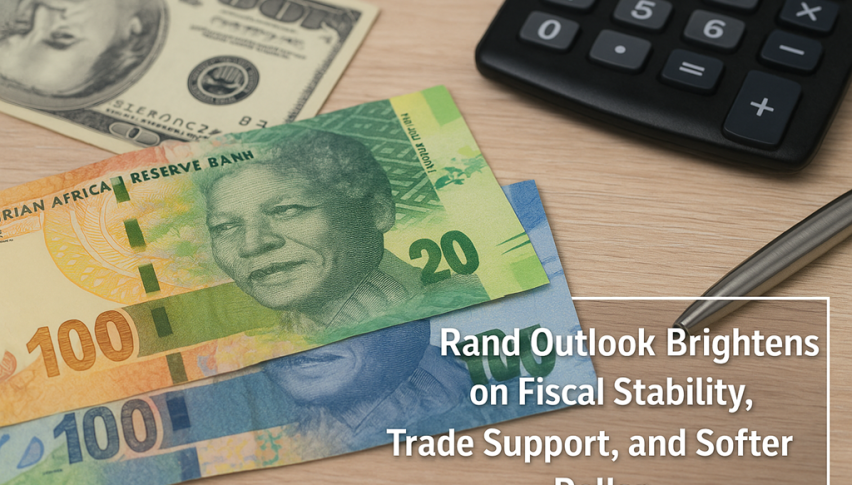South African Rand Forecast: USD/ZAR Poised to Extend Below R17 In Spite of SARB Decision
The rand’s uptrend continues, supported by improving fiscal signals, firmer global risk appetite, and persistent pressure on USD/ZAR.

Quick overview
- The South African rand continued its uptrend last week, bolstered by improving fiscal signals and a firmer global risk appetite.
- Investor confidence and a weaker U.S. dollar allowed USD/ZAR to break below the psychological level of R17.
- Upcoming economic data releases, including inflation and retail sales, could influence the rand's trajectory, with a potential interest rate cut from the SARB on the horizon.
- South Africa's removal from the FATF 'grey list' and record foreign exchange reserves further enhance the rand's long-term stability.
The rand’s uptrend continued last week, supported by improving fiscal signals, firmer global risk appetite, and persistent technical pressure on USD/ZAR.
Rand Recovery Gains Pace
The South African rand strengthened again last week after a brief early-November pullback sent USD/ZAR to R17.58. Renewed investor confidence and a weaker U.S. dollar helped the currency regain momentum, allowing the pair to break below R17 — a psychological level reinforced by stable policy direction and rising risk demand.
USD/ZAR Chart Weekly – The 200 SMA Provided Resistance
Although Friday saw a mild rebound in USD/ZAR due to profit-taking ahead of S&P Global’s sovereign rating update, sentiment toward the rand remained broadly constructive.
Volatility Settles, but Caution Remains
The return of volatility earlier in the month reflected traders’ sensitivity to tariff headlines and global risk swings. South Africa’s rating history also continues to shape investor behavior, with memories of the 2017 downgrade — linked to policy instability under former President Jacob Zuma — prompting caution ahead of each ratings cycle.
Still, technical indicators signal that USD/ZAR remains under downward pressure. Moving averages have acted as firm resistance, reinforcing a directional bias that favors further rand appreciation and a potentially more sustained break below R17 in the near term.
Key Economic Data Ahead
Next week introduces several market-moving releases.
- Inflation (October) and retail sales (September) arrive on Wednesday.
- The SARB interest rate decision follows on Thursday, with markets pricing an 80% chance of a 25-basis-point cut.
However, Investec Chief Economist Annabel Bishop warns that the central bank could delay easing due to the U.S. Federal Reserve’s more cautious stance and a slight rise in local inflation, which reached 3.4% in September and is expected to hover near 3.5% in Q4. Although above the new 3% inflation target, the SARB has indicated short-term flexibility as it transitions to the revised framework.
Fiscal Policy Stability Supports Sentiment
The rand’s broader narrative received further reinforcement from last week’s medium-term budget policy statement by Finance Minister Enoch Godongwana.
Key takeaways included:
- GDP growth projected at 1.2% in 2025, more than double last year’s pace.
- National debt stabilizing relative to GDP for the first time since 2008.
- R4.8 billion in savings from lower debt-service costs.
- R15.8 billion in additional spending enabled by stronger VAT and SARS collections.
Funding priorities range from early childhood development and the HIV programme to KwaZulu-Natal flood repairs, rebuilding Parliament, and supporting the 2026 municipal elections.
Revenue Gaps and Spending Controls Ahead
Despite better near-term collections, Treasury expects an overall revenue shortfall of R15.7 billion over the next two years. To mitigate this:
- Low-priority programs will be shut, saving R6.7 billion.
- Social-grant fraud and double-dipping will be targeted for elimination.
- Underperforming municipalities will face stricter access to infrastructure grants.
- Tax hikes worth R20 billion in 2026 remain on the table unless SARS outperforms.
Godongwana emphasized that the path forward is straightforward: if revenue misses targets, government must either increase taxes or reduce spending.
Trade and Global Risk Environment Lend Additional Support
Improved U.S.–China diplomatic engagement, including tariff reductions and eased export controls, has lifted sentiment across emerging markets. The rand has been a direct beneficiary as appetite for risk assets improves.
Domestically, the SARB’s measured and predictable policy stance continues to bolster credibility and attract steady inflows, offering additional support to the currency.
Structural Shifts Enhance Long-Term Outlook
South Africa’s removal from the FATF “grey list” marked a turning point, reducing funding costs and unlocking new investment channels. Optimism surrounding AGOA’s renewal has also strengthened trade prospects, while rising commodity prices — including gold’s rebound above $4,200 — have buoyed the rand through stronger export receipts.
Reserves at Record Levels Strengthen Stability
Foreign exchange reserves reached a record $71.55 billion in October, driven by higher gold holdings and increased foreign assets. This robust buffer enhances South Africa’s ability to absorb external shocks and solidifies the rand’s long-term stability heading into 2025.
- Check out our free forex signals
- Follow the top economic events on FX Leaders economic calendar
- Trade better, discover more Forex Trading Strategies
- Open a FREE Trading Account



